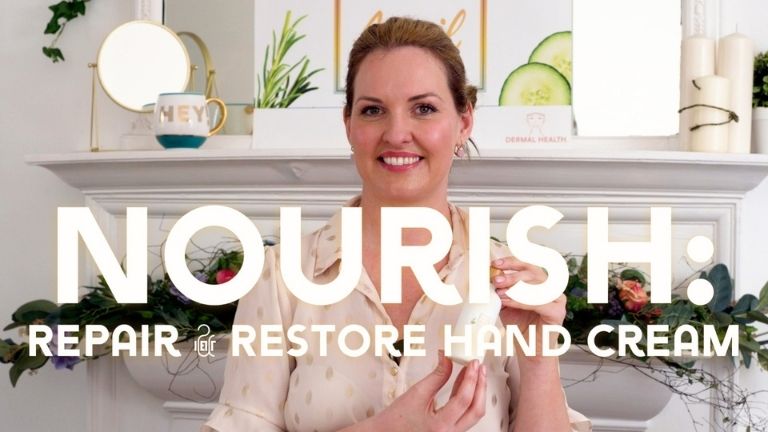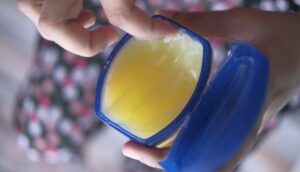Did you know that Vaseline is THE safest product to apply to skin? For our next Anti-Ageing April video recipe, Una Jefford reveals how to make a restoring hand cream using this well-known cosmetic product
From shampoo, body wash and toothpaste to deodorant, face creams and hair products – every day we expose ourselves to around 126 different chemicals through grooming products.
These chemicals are able enter our bodies and bloodstream through our skin.
That’s why Healthista is dedicating its full attention to Anti-Ageing April – a time to focus and provide some TLC to our much loved skin through the use of beauty products created with all natural ingredients.
directing your attention to more natural, inexpensive ingredients
Harley street resident skin expert, Una Jefford from Dermal Health, will be directing your attention to more natural, inexpensive ingredients, of which some are food-based beauty superstars that you can probably find in your cupboards.
We would love you all to create these homemade products yourself and let us know how you got on by tagging #antiageingapril #HealthistaTV #dermalhealth on Instagram.
Nourish: Restore & Repair Hand Cream
Our next Anti-Ageing April video is how to make a restorative hand cream using, glycerin, bakuchiol, frankincense and Vaseline (or another type of petroleum jelly).
This week we will be focussing on Vaseline, otherwise known as petroleum jelly that has been in use for over 150 years – in fact I am sure everyone reading this has some in their cupboard right now!
Vaseline was the first cosmetic grade petroleum jelly to be patented and was discovered by an American chemist who developed the substance from rod wax back in 1870.
he ate a teaspoon of it daily and lived to 96 years old
The chemist who developed it, Robert Augustus Chesebrough, believed so strongly in the products healing abilities he ate a teaspoon of it daily and lived to 96 years old, passing away in 1933.
Vaseline remains today an excellent occlusive moisturiser, why? It’s greasy consistency acts as a covering layer and stops your skin from losing any of its water. This is called transepidermal water loss.
This helps to reinforce the skins natural barrier function which is particularly helpful in the cold wintery months as it can protect you from wind burn.
Vaseline is also a lifeline for people with very dry skin or eczematous skin concerns.
I hear a lot of people worried that petroleum jelly comes from petrol, and therefore must be dangerous or harmful to the skin, however these fears could not be further from the truth.
Firstly, Vaseline is a ‘cosmetic’ graded product that has been designed and refined (the whiter the jelly the more refined it is) to be applied to your skin and is in fact one of the safest things you can apply to your skin. This is because it is inert and does not bind to any cells of the skin.
This inability to bind to anything means it is impossible to be allergic to petroleum jelly or develop an irritation. It is completely non-sensitising, meaning that it will not make your skin react in any way.
Within dermatology we use it as a negative control in patch testing, when testing allergies to other allergens.
What is Vaseline ‘Slugging’?
Applying a layer of petroleum jelly over your skin to seal in serums and moisturisers has in recent years become known as ‘Slugging’.
The idea is that the petroleum jelly helps to seal in the nutrients underneath and penetrate it into the skin.
Within dermatology we even recommended it to be applied to wounds when they are healing to stop them from drying out and to improve the appearance or the scar.
it can still help seal in bacteria, sebum, and other skin cells
However, I would not recommend this for acne prone or oily skins.
Although this jelly is non-comedogenic, it can still help seal in bacteria, sebum, and other skin cells already active into the skin.
This would provide a perfect breeding ground to multiply and so exasperate these skin types, causing a breakout.
More From Anti-Ageing April:
Anti-Ageing April Recipe #1: Green Tea Facial Toner with Apple Cider Vinegar
Anti-Ageing April Recipe #2: Himalayan Salt Exfoliator Scrub with Apple Cider Vinegar
More Healthista Content:
How to transform your diet in 5 easy steps
4 signs your low mood shouldn’t be ignored plus what may help
Best diet for menopause – an interview with Dr Clare Bailey
From better sex to blissful sleep – 3 reasons you NEED to try CBD
3 healthy breakfast recipes that will keep you full till lunch
Like this article? Sign up to our newsletter to get more articles like this delivered straight to your inbox.






















































